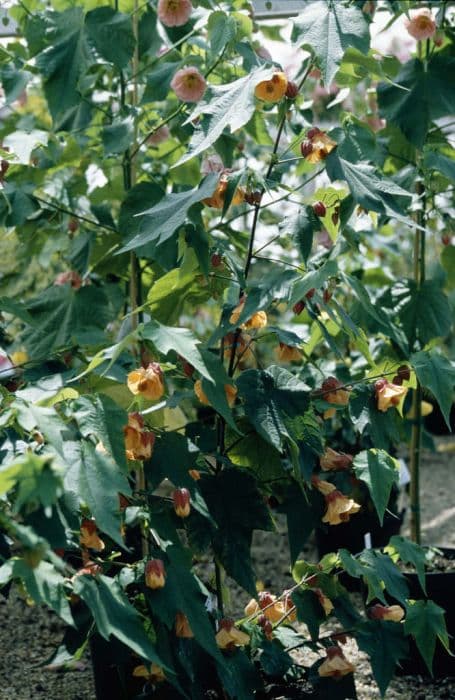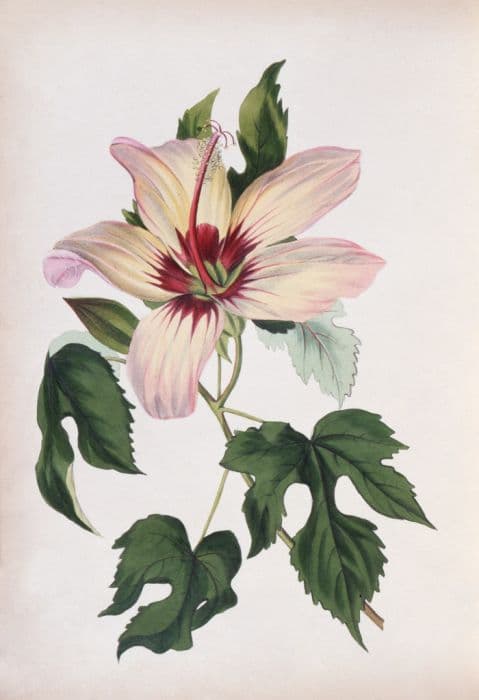Marshmallow Althaea officinalis

ABOUT
Althaea officinalis, commonly known as marshmallow, is a perennial plant that is notable for its soft, hairy stems and leaves. The leaves are broad and ovate, often with a heart-shaped base, and exhibit a velvety texture due to a covering of fine, soft hairs. They are arranged in an alternating pattern along the stem. The marshmallow plant produces a profusion of delicate flowers, which are typically a pale pink or light white color. These flowers are small and have five heart-shaped petals, creating a subtle and attractive display. They grow in clusters along the upper parts of the plant's stems, adding to its ornamental appeal. The root system of the marshmallow plant is fibrous and is traditionally harvested for its mucilaginous properties. The roots are thick and tapering, and they play a key role in the historical and medicinal significance of the plant. The overall appearance of the marshmallow plant exudes a gentle and soothing aesthetic, which reflects its traditional uses in herbal medicine.
About this plant
 Names
NamesFamily
Malvaceae.
Synonyms
Marshmallow, Common Marshmallow, White Mallow, Marsh Mallow.
Common names
Althaea kragujevacensis, Althaea micrantha, Althaea sublobata, Althaea taurinensis, Althaea vulgaris.
 Toxicity
ToxicityTo humans
Marshmallow (Althaea officinalis) is not considered toxic to humans. In fact, it has been used historically and in herbal medicine for its potential benefits, such as soothing sore throats and as a cough suppressant. There is typically no risk of poisoning from ingesting the plant, and no common symptoms of poisoning associated with marshmallow.
To pets
Marshmallow (Althaea officinalis) is also not known to be toxic to pets. It is unlikely to cause any symptoms of poisoning or adverse health consequences if ingested by animals such as dogs or cats. As with any non-food plant, it is still advisable to monitor your pet and prevent them from ingesting large amounts, as it could potentially cause gastrointestinal upset simply due to the ingestion of non-dietary fiber.
 Characteristics
CharacteristicsLife cycle
Perennials
Foliage type
Deciduous
Color of leaves
Green
Flower color
Pink
Height
5 feet (1.5 meters)
Spread
2 feet (0.61 meters)
Plant type
Herb
Hardiness zones
3
Native area
Europe
Benefits
 General Benefits
General Benefits- Edible parts: Althaea officinalis, commonly known as marshmallow plant, has edible leaves, roots, and flowers that can be used in culinary applications such as herbal teas, sweets, and as a thickening agent.
- Ornamental value: With its pale pink flowers and attractive foliage, it can add aesthetic value to gardens and landscapes.
- Wildlife habitat: The marshmallow plant can provide habitat and food for a variety of wildlife, including beneficial insects and birds.
- Traditional uses: Historically, different parts of the plant have been used for various non-medical household applications, such as making paper and as a natural fabric softener.
- Soil improvement: Its deep roots can help improve soil structure by aerating the soil and enhancing moisture retention.
 Medical Properties
Medical Properties- Demulcent: Althaea officinalis, commonly known as marshmallow, contains mucilage which can soothe irritated mucous membranes in the mouth and throat.
- Emollient: It may be used topically to soothe and soften the skin.
- Antitussive: The mucilaginous properties can also help in relieving coughs.
- Anti-inflammatory: Marshmallow has been traditionally used to reduce inflammation in the respiratory tract and digestive system.
- Gastrointestinal soother: It may help in relieving irritation and inflammation in the stomach and intestines.
- Diuretic: The plant is sometimes used to increase urine flow and soothe the urinary tract.
- Wound healing: Used topically in poultices to help with the healing of minor wounds and skin irritations.
 Air-purifying Qualities
Air-purifying QualitiesThis plant is not specifically known for air purifying qualities.
 Other Uses
Other Uses- Marshmallow root is traditionally used as a food source, where the root of the plant is boiled and sweetened to make a confectionery that was the original inspiration for the modern marshmallow treat.
- As a natural fiber source, the stems of the marshmallow plant have been used historically to make paper and textiles, capitalizing on its strong yet pliable bast fibers.
- In gardening and horticulture, marshmallow plants are grown as ornamentals for their attractive flowers, contributing to the aesthetic appeal of gardens and landscapes.
- Marshmallow sap, due to its mucilaginous properties, has been used as a natural adhesive in various traditional crafts and bookbinding practices.
- The marshmallow plant can be utilized as a natural dye, with different parts of the plant producing subtle colors for fabrics and textiles.
- It has been involved in ceremonies and traditional rituals in various cultures, where parts of the marshmallow plant symbolize healing and protection.
- Marshmallow leaves are sometimes used as a natural potpourri or herbal sachets, contributing a gentle fragrance when dried and placed among linens and clothing.
- The flowers of the marshmallow plant are edible and can be used as decorative, flavorful additions to salads and desserts.
- Biomass from the marshmallow plant can contribute to compost piles or be processed into biofuel, utilizing its organic matter for environmental sustainability.
- In some rural practices, marshmallow has been used as animal fodder, providing nutrition especially for horses and cattle.
Interesting Facts
 Feng Shui
Feng ShuiThe Marshmallow plant is not used in Feng Shui practice.
 Zodiac Sign Compitability
Zodiac Sign CompitabilityThe Marshmallow plant is not used in astrology practice.
 Plant Symbolism
Plant Symbolism- Healing: Althaea officinalis, commonly known as Marshmallow plant, has been used for its medicinal properties since ancient times. Its symbolism of healing stems from its effective soothing properties for coughs and sore throats.
- Protection: The mucilaginous substance of the marshmallow plant was believed to form a protective barrier, symbolizing safety and shelter against physical and spiritual harm.
- Love: In the language of flowers, marshmallow plant has been associated with the attraction of love, possibly owing to its soft, velvety leaves and gentle nature.
- Compassion: The plant's traditional uses in herbal medicine to relieve pain and discomfort make it a symbol of compassion and caring for others.
 Water
WaterMarshmallow plants prefer moist soil, so regular watering is essential. Water them deeply once every week, providing about 1 to 2 gallons per plant, depending on the soil and weather conditions. During hot and dry spells, you might need to water twice a week to maintain moisture. It is important to avoid waterlogging the soil, thus ensure good drainage. Always water at the base of the plant to keep the leaves dry and prevent fungal diseases.
 Light
LightThe marshmallow plant thrives best in full sun to partial shade. For optimal growth, place the plant in an area where it will receive at least six hours of sunlight per day. If you are growing the plant indoors, it should be positioned by a sunny window where it can get a lot of bright but indirect light.
 Temperature
TemperatureMarshmallow plants are hardy and can tolerate a wide temperature range. They perform best in temperatures between 50°F and 90°F. The plants can survive minimum temperatures down to around 20°F. To ensure healthy growth, avoid exposing the plant to extreme heat or frost.
 Pruning
PruningPruning marshmallow plants is primarily done to shape the plant and remove dead or diseased stems. Pruning should be performed in early spring before new growth starts. Depending on the plant's size and growth rate, a light annual pruning is generally sufficient. The best time for major pruning work is after the plant has finished flowering.
 Cleaning
CleaningAs needed
 Soil
SoilMarshmallow (Althaea officinalis) thrives in well-draining, loamy soil with a pH ranging from 6.0 to 8.0. A mix of garden soil, compost, and sand or perlite can create an ideal growing medium, ensuring nutrients and adequate drainage for plant health.
 Repotting
RepottingMarshmallow plants typically do not require frequent repotting. It is generally recommended to repot these perennials every 2-3 years or when the root system has outgrown the current container, ensuring continued growth and health.
 Humidity & Misting
Humidity & MistingMarshmallow plants are adaptable but prefer a moderate humidity level. They do not require any special humidity conditions and can thrive in the average outdoor humidity levels found in their growing zones.
 Suitable locations
Suitable locationsIndoor
Place marshmallow in bright, indirect light with room to grow.
Outdoor
Plant marshmallow in sun to part shade, well-drained soil.
Hardiness zone
3-9 USDA
 Life cycle
Life cycleAlthaea officinalis, commonly known as marshmallow, begins its lifecycle as a seed, which germinates in moist soil in spring. After germination, the seedling emerges and develops into a young plant with a deep-reaching taproot and a rosette of leaves. As the plant matures, it grows upright stems and produces fuzzy, heart-shaped leaves and stems. During the summer months, the marshmallow plant blooms with pale pink flowers that are attractive to bees and other pollinators. After pollination, the flowers develop into small, flat, round seeds that are encased in a papery calyx, which are dispersed by wind or water. The plant is a perennial and will enter a period of dormancy in the winter before resuming growth in the spring.
 Propogation
PropogationPropogation time
Spring to Summer
Propogation: Marshmallow (Althaea officinalis) is commonly propagated by seeding. The best time for sowing the seeds is in spring after the threat of frost has passed, or in the fall where mild winters are expected. To propagate by seed, one must first prepare a bed with well-draining soil, as marshmallow does not thrive in waterlogged conditions. Sow the seeds about 1/4 inch deep (approximately 6 millimeters) and space them a few inches apart to allow room for growth. Keep the soil moist until germination, which typically occurs in 2 to 4 weeks. After seedlings have grown enough to handle, they can be transplanted to their final growing location, ensuring they are spaced about 2 feet (61 centimeters) apart to accommodate their mature size.









